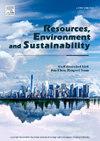Potential decarbonization for balancing local and non-local perishable food supply in megacities
IF 12.4
Q1 ENVIRONMENTAL SCIENCES
引用次数: 0
Abstract
Ensuring urban food security while reducing carbon emissions from food systems is a key challenge. Food localization can reduce transport emissions; however, its role in agricultural production emissions reductions is unclear. Here, we explored the effects of localization of seven perishables, incorporating emissions from production and cold-chain logistics, in Beijing and Shanghai, China; determined decarbonization under different scenarios by increasing or decreasing the localization, with or without constrains, of each food category (balancing strategy). The results show that every 1% increase in the localization of vegetables, poultry, and aquatic products decreased 2020 emissions by 0.4–1.9 tCO2e, but for beef and lamb, it increased emissions by 0.2–2.9 tCO2e. Localization decreased cold-chain emission shares for all foods. The balancing strategy with constraints reduced emissions by 0.76 MtCO2e (5%) and 0.44 MtCO2e (2%) in 2020 in Beijing and Shanghai, respectively. Utilizing urban agriculture at all costs (i.e., without constraints) further reduced emissions by a factor of 3–4. Over 90% of Beijing’s emissions added by 2035 under the business-as-usual scenario were projected to be offset by the strategy. In Shanghai, the strategy could reduce emissions by an additional 0.44 MtCO2e. The results indicate that expanding imports of carbon-intensive ruminant meat to replace local production and reallocating urban resources to vegetables, poultry, and aquatic products could lead to more sustainable food supplies in megacities. Further development of cold-chain logistics is expected to reduce emissions in synergy with the balancing strategy. Our results could help inform better food system planning in megacities.

在大城市中平衡本地和非本地易腐食品供应的潜在脱碳
在确保城市粮食安全的同时减少粮食系统的碳排放是一项关键挑战。食品本地化可以减少运输排放;然而,它在农业生产减排中的作用尚不清楚。在这里,我们探讨了中国北京和上海七种易腐食品本地化的影响,包括生产和冷链物流的排放;通过增加或减少每种食物类别的本地化(有或没有限制)来确定不同情景下的脱碳(平衡策略)。结果表明,蔬菜、家禽和水产品本地化每增加1%,2020年排放量将减少0.4-1.9 tCO2e,但牛肉和羊肉的排放量将增加0.2-2.9 tCO2e。本地化降低了所有食品的冷链排放份额。有约束的平衡策略在2020年分别使北京和上海的排放量减少了0.76亿吨二氧化碳当量(5%)和0.44亿吨二氧化碳当量(2%)。不惜一切代价(即不受限制)利用城市农业进一步减少了3-4倍的排放量。预计到2035年,北京在“一切照旧”情景下增加的排放量中,90%以上将被该战略抵消。在上海,该战略可额外减少0.44亿吨二氧化碳当量的排放量。研究结果表明,扩大碳密集型反刍动物肉类的进口以取代当地生产,并将城市资源重新分配给蔬菜、家禽和水产品,可能会使特大城市的粮食供应更加可持续。冷链物流的进一步发展有望与平衡战略协同减少排放。我们的研究结果可以为大城市更好的食品系统规划提供信息。
本文章由计算机程序翻译,如有差异,请以英文原文为准。
求助全文
约1分钟内获得全文
求助全文
来源期刊

Resources Environment and Sustainability
Environmental Science-Environmental Science (miscellaneous)
CiteScore
15.10
自引率
0.00%
发文量
41
审稿时长
33 days
 求助内容:
求助内容: 应助结果提醒方式:
应助结果提醒方式:


